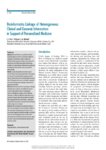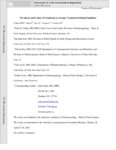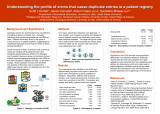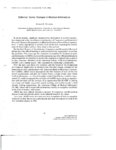Filters: Collection: "ir_uspace"
| Creator | Title | Description | Subject | Date | ||
|---|---|---|---|---|---|---|
| 51 |
 |
Gerig, Guido | Vessel tortuosity and brain tumor malignancy: a blinded study | Rationale-Malignancy provokes regional changes to vessel shape. Characteristic vessel tortuosity abnormalities appear early during tumor development, affect initially healthy vessels, spread beyond the confines of tumor margins, and do not simply mirror tissue perfusion. The ability to detect and qu... | Computer; Cancer; Blood vessels; Tortuosity; MRA; Brain tumor | 2005-01-01 |
| 52 |
 |
Gerig, Guido | Abnormal vessel tortuosity as a marker of treatment response of malignant gliomas: preliminary report | Despite multiple advances in medical imaging, noninvasive monitoring of therapeutic efficacy for malignant gliomas remains problematic. An underutilized observation is that malignancy induces characteristic abnormalities of vessel shape. These characteristic shape abnormalities affect both capillari... | 2004-01-01 | |
| 53 |
 |
Mitchell, Joyce A. | Bioinformatics linkage of heterogeneous clinical and genomic information in support of personalized medicine | Objectives: Biomedical Informatics as a whole faces a difficult epistemological task, since there is no foundation to explain the complexities of modeling clinical medicine and the many relationships between genotype, phenotype, and environment. This paper discusses current efforts to investigate su... | 2007-01-01 | |
| 54 |
 |
Roy, Nelson | Prevalence and causes of dysphonia in a large treatment-seeking population | Objective: To determine the prevalence and common causes of dysphonia as diagnosed by primary care physicians (PCPs) and otolaryngologists, and to evaluate differences in etiologies offered by these providers. Study Design: Retrospective analysis of data from a large, nationally representative admin... | 2012-01-01 | |
| 55 |
 |
Research in brief: Spring 2002 | Summaries of Selected Research Projects at the University of Utah Health Sciences Center | Research: School of Medicine, College of Pharmacy;, College of Nursing, College of Health | 2002-03 | |
| 56 |
 |
Kendall, Katherine A. | Comparing quality of life scores to objective measures of swallowing function after chemoradiation therapy for oropharyngeal carcinoma | 2013-05-11 | ||
| 57 |
 |
Research in brief: Winter 1998 | Summaries of Selected Research Projects at the University of Utah Health Sciences Center | Research: School of Medicine, College of Pharmacy;, College of Nursing, College of Health | 1998-12 | |
| 58 |
 |
DuVall, Scott L. | Understanding the profile of errors that cause duplicate entries in a patient registry | Duplicate records are detrimental to the cost-effective and efficient delivery of health care. Manually identifying and resolving duplicates can cost $60 per case. Patterns have been found in the types of errors that occur in patient registries, suggesting that undetected duplicate records may be ... | Duplicate records; Duplicate patient records; Profile of errors; Enterprise Data Warehouse; EDW; Utah Population Database; UPDB; Trapeze Interactive Poster | 2009 |
| 59 |
 |
KUTV news featurette on cloning, molecular genetics, and disease aired November 9, 1997 | This 3 minutes, 1 second video clip from Salt Lake City's KUTV, Channel 2 features a short interview with Mario Capecchi concerning cloning and its use in molecular genetics and the study of human diseases. | Gene targeting; Genetic engineering; Molecular genetics; Cancer Research; Capecchi, Mario R.; Science - Moral and ethical aspects; Human chromosome abnormalities - Diagnosis; Television feature stories | 1997-11-09 | |
| 60 |
 |
Schmidt, Meic H.; Kestle, John R. W. | Treatment of metastatic spinal epidural disease: a review of the literature | Object. Spinal cord compression is one of the most dreaded complications of metastatic cancer. It can lead to a number of sequelae, including pain, spinal instability, neurological deficits, and a reduction in the patient's quality of life. Except in selected circumstances, treatment is palliative. ... | Spinal cord compression; Metastasis; Radiation therapy; Stereotactic radiosurgery | 2003 |
| 61 |
 |
Coffin, Cheryl M.; Capecchi, Mario R. | Alveolar rhabdomyosarcomas in conditional Pax3:Fkhr mice: cooperativity of Ink4a/ARF and Trp53 loss of function. | Alveolar rhabdomyosarcoma is an aggressive childhood muscle cancer for which outcomes are poor when the disease is advanced. Although well-developed mouse models exist for embryonal and pleomorphic rhabdomyosarcomas, neither a spontaneous nor a transgenic mouse model of alveolar rhabdomyosarcoma has... | Cell Differentiation; Forkhead Transcription Factors; Myogenic Regulatory Factors | 2004-11-01 |
| 62 |
 |
Research in brief: Spring 2005 | Summaries of Selected Research Projects at the University of Utah Health Sciences Center | Research: School of Medicine, College of Pharmacy;, College of Nursing, College of Health | 2005-03 | |
| 63 |
 |
Wen, Ming | UGT1A1*28 polymorphism as a determinant of irinotecan disposition and toxicity | The metabolism of irinotecan (CPT-11) involves sequential activation to SN-38 and detoxification to the pharmacologically inactive SN-38 glucuronide (SN-38G). We have previously demonstrated the role of UGT1A1 enzyme in the glucuronidation of SN-38 and a significant correlation between in vitro glu... | UGT1A1*28 polymorphism; Irinotecan disposition; Irinotecan toxicity; Glucuronidation; SN-38 | 2002 |
| 64 |
 |
Nelson, Christopher | Foods factor in new medications | Understanding how nutrients in food affect cell communication could hold the key to a new generation of medications to treat diesase. Research designed to explain nutrition at the molecular level is not a new concept, but there is still much that is not understood. If we can figure out which bioacti... | Cell Signaling; Food Factors; Medications; Nutrition | 2000-03 |
| 65 |
 |
Andy King | "Skin self-examinations and visual identification of atypical nevi: Comparing individual and crowdsourcing approaches." Cancer Epidemiology< | 2013-09-12 | ||
| 66 |
 |
Digre, Kathleen B.; Blumenthal, Deborah T.; Salzman, Karen L.; Jensen, Randy L.; Dunson, William A. | Early pathologic findings and long-term improvement in anti-Ma2-associated encephalitis. | A 67-year-old man sequentially developed anti-Ma2-associated paraneoplastic encephalitis (PNE) and contralateral herpes simplex encephalitis (HSE). Brain biopsy 1 month before HSE revealed extensive infiltrates of T cells, B cells, and plasma cells. Most T cells expressed the cytotoxic granule-assoc... | Paraneoplastic neurologic disorders; Encephalitis; Neoplasm;Herpes Simplex | 2006-07-11 |
| 67 |
 |
Mitchell, Joyce A. | Nanoinformatics: a new area of research in nanomedicine | Abstract: Over a decade ago, nanotechnologists began research on applications of nanomaterials for medicine. This research has revealed a wide range of different challenges, as well as many opportunities. Some of these challenges are strongly related to informatics issues, dealing, for instance, wit... | 2012-01-01 | |
| 68 |
 |
Mineau, Geraldine Page | Quantification of the familial contribution to müllerian anomalies | Cases of müllerian anomalies, identified by International Classification of Diseases and Current Procedural Terminology codes from January 1994 to March 2006, were collected from the largest hospital systems in the state of Utah. All records were subsequently matched to the Utah Population Databas... | Mullerian anomalies; Utah Population Database; UPDB | 2008 |
| 69 |
 |
Schmidt, Meic H. | Role of photodynamic therapy in posterior fossa brain tumors: a preclinical study in a canine glioma model | Photodynamic therapy was studied in dogs with and without posterior fossa glioblastomas. This mode of therapy consisted of intravenous administration of Photofrin-II at doses ranging from 0.75 to 4 mg/kg 24 hours prior to laser light irradiation in the posterior fossa. Tissue levels of Photofrin-l... | Brain neoplasm; Posterior fossa; Photodynamic therapy; Glioblastomas; Dog; Photofrin-II; Canine glioma model | 1993 |
| 70 |
 |
Couldwell, William T. | Astrocytoma cell line | TO THE EDITOR: It has long been established clinically that patients with neurofibromatosis Type 1 (NF1) have an increased susceptibility to develop many central and peripheral tumors. The nature of the genetic alterations underlying NF1 have recently begun to be characterized. It has been demo... | 2001 | |
| 71 |
 |
Mongia, Shella K.; Rawlins, Mindy, L.; Owen, William E.; Roberts, William L. | Performance characteristics of seven automated CA125 assays | Author manuscript. Cancer antigen 125 (CA125) is a high molecular mass glycoprotien, which is used as tumor marker to monitor disease progression, response to therapy and in early detection of recurrence after treatment for ovarian cancer. The Access 2, ADVIA Centaur, ARCHITECT i2000, AxSYM, Elecsys... | CA125 assays | 2005-08-29 |
| 72 |
 |
Warner, Homer R. | Some Changes in Medical Informatics (Editorial) | Biomedical Informatics | 1990 | |
| 73 |
 |
Frey, Lewis J. | ca! - emergency and disaster recovery system extensions to caBIG™ | During Hurricane Katrina, US Federal and State Agencies had disparate data acquisition systems, separate data networks and unique incompatible applications. •System incompatibilities exist even between various Federal agencies. •Consistent data available to one agency should be available to an... | caBIG; Data acquisition systems; Data sharing; Information sharing; Trapeze Interactive Poster | 2009-09-23 |
| 74 |
 |
Viskochil, David H. | Malignant peripheral nerve sheath tumors in neurofibromatosis type 1: a multicenter project with 3 clinical trials | A major goal of this CTDA proposal is to optimize subject recruitment in each of the clinical trials. Using the prevalence estimate for NF1 as 1 in 3,500 individuals in the population at large coupled with the cross-sectional estimate of 5% affected by MPNST, we acknowledge that few centers will hav... | 2006 | |
| 75 |
 |
Couldwell, William T. | Protein kinase C inhibitors suppress cell growth in established and low-passage glioma cell lines. a comparison between staurosporine and tamoxifen | WE HAVE PREVIOUSLY demonstrated that the proliferation of established human glioma cell lines correlated with protein kinase C (PKC) activity and that a relatively selective PKC inhibitor, staurosporine, inhibits glioma cell proliferation. The purpose of this study was to determine whether low-passa... | Staurosporin; Tamoxifen; Protein kinase C; Glioma; Brain neoplasm; Glioma cell lines | 1993 |
